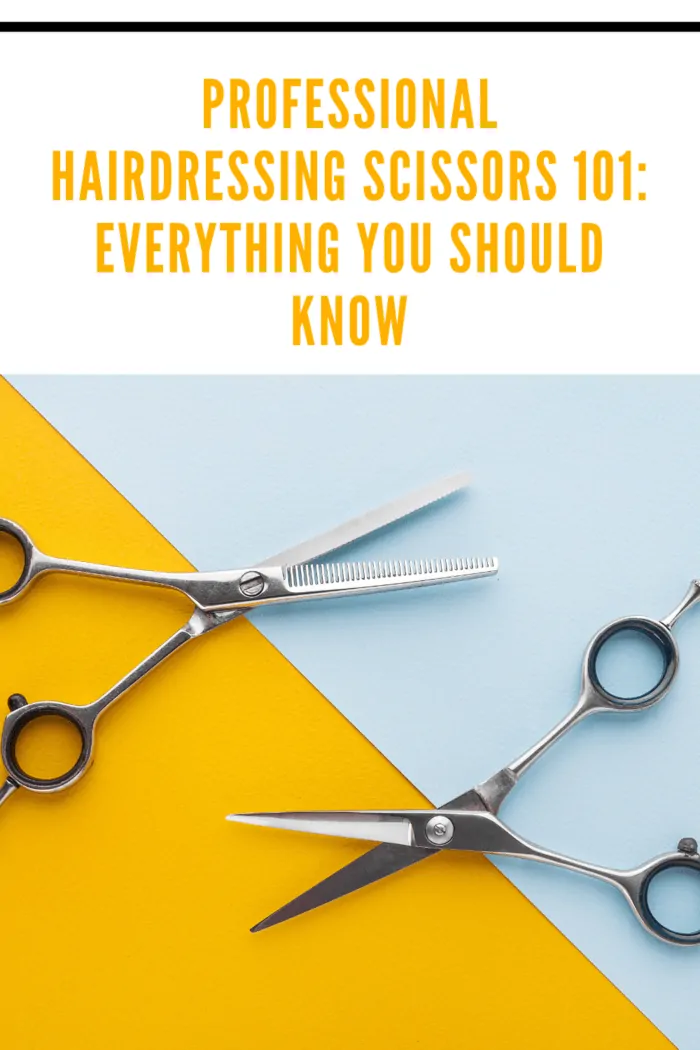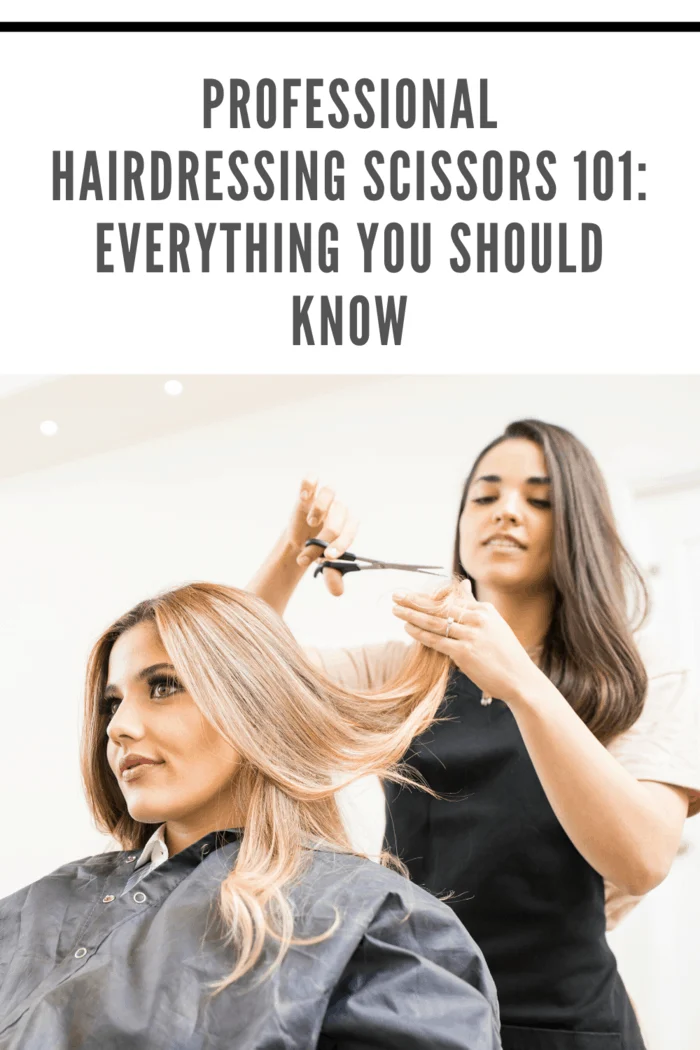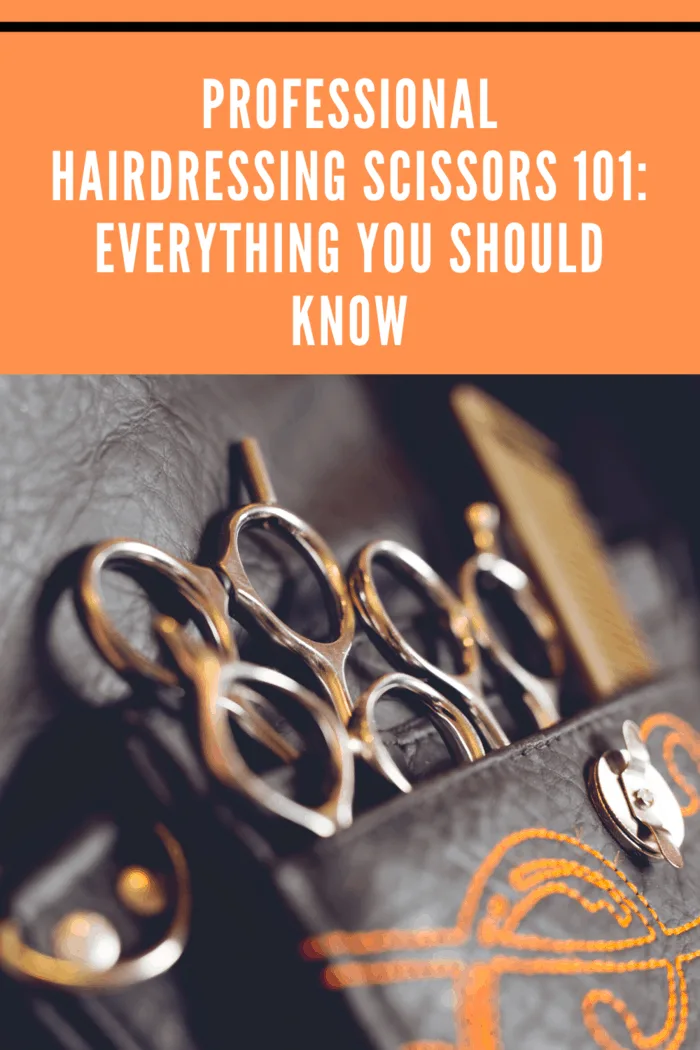The type and quality of hairdressing scissors you purchase can make or break your hairstyle.
That’s why you should get it right during the purchase.
You are sure of the quality, guarantee, and quality cuts with the right scissors.
However, there are lots of options on the market.
This makes it difficult to choose a product that suits your explicit needs.
But you can use this guide and land the best hairdressing scissors for a perfect haircut (NBC).

Professional Hairdressing Scissors 101: Everything You Should Know
The Basics
According to Allure, to create beautiful haircuts, every hairdresser needs to have the right pair of scissors.
But finding the right pair for your needs isn’t always easy.
You’ll first need to determine the cutting styles you execute more often.
Doing this will help you choose the shape of scissors that are well-suited to your cutting technique.
Smaller-sized scissors typically create a more precise shape whereas longer ones are better for advanced techniques such as utilizing the scissor over the comb as well as more basic trims.
When deciding on the type of scissors to invest in, it’s always advisable to start by measuring the length of its blade against your middle finger.
Then, measure the scissor’s total length against the palm of your hand.
And it’s also worth noting that most hairdressing scissors cover an extensive range of cuts varying from 4.5 to 8 inches.
You’ll always feel more comfortable and less fatigued with the right pair of scissors.
There are three common scissor shapes, including classic, offset, and a crane.

The Type of Cut
Hairdressing scissors can be utilized in several ways to create different haircuts:
Blades
Perfect for beginners, serrated or micro-serrated scissors are often outfitted with one blade featuring serrations that grip the hair, creating a straight cut.
However, they aren’t suitable for slice cutting and chopping.
Generally speaking, convex-edge scissors are the sharpest cutting blades and make a perfect choice for slice cutting as well as chopping.
What are Convex-Edge Scissors?
Convex-edge hair cutting scissors are a type of professional hair cutting tool that features a blade with a curved edge that is sharpened to a fine point. The blade’s edge is slightly curved inward, creating a convex shape. This curvature allows for a smooth and effortless cutting motion, which is why many professional hairdressers and barbers prefer them.
The convex edge design of these scissors allows for a clean and precise cut on any type of hair, including thick or coarse hair. The blade’s curved shape enables the user to cut hair without pushing or bending the hair, ensuring a natural-looking haircut.
These scissors are usually made from high-quality materials, such as high-carbon steel or stainless steel, and are often coated with a non-stick material to prevent hair from sticking to the blades.
Convex-edge hair cutting scissors are a valuable tool for anyone who wants to achieve a professional-looking haircut or hairstyle. However, they require proper maintenance and sharpening to ensure they continue to provide clean and precise cuts.
Holding the Scissors When Creating Cuts
The way you hold the scissors can have a significant impact on the outcome of a haircut. Holding the scissors correctly is essential for achieving precise and even cuts and preventing any damage to the hair.
Here are some ways holding the scissors can affect a haircut:
- Angle of the scissors: The angle at which you hold the scissors can affect the shape and length of the hair you cut. Holding the scissors at a 45-degree angle will result in a more textured and layered look, while holding them at a 90-degree angle will result in a blunt cut.
- Tension of the blades: The tension of the blades determines how much pressure is applied when cutting the hair. Holding the scissors too loosely can result in a jagged or uneven cut, while holding them too tightly can cause damage to the hair or result in an uneven cut.
- Position of the fingers: The position of your fingers on the scissors can also affect the way you cut the hair. Placing your fingers too close to the blades can result in accidental cuts or nicks, while placing them too far back can reduce your control over the scissors.
- Hand position: The way you position your hand when holding the scissors can affect the length and shape of the hair you cut. Holding the scissors vertically will result in a more precise and controlled cut, while holding them horizontally will result in a softer, more natural look.
Overall, holding the scissors correctly is crucial for achieving the desired haircut or hairstyle. It takes time and practice to develop the proper technique and achieve consistent results.
Vertical Cutting & Straight-Line Cutting
When doing vertical or straight-line cutting, it’s important to hold the scissors in a vertical direction.
But the best scissors for these types of tasks are fully offset scissors.
Blunt Cutting
This includes bobs as well as one length.
For example, for a blunt haircut, you’ll want to hold your scissors at a 90-degree angle, parallel to the hair.
Here are the steps to hold scissors correctly for a blunt haircut:
- Hold the scissors with your dominant hand and rest your ring finger and pinky finger on the lower blade’s finger hole, while your thumb and index finger go in the upper finger hole.
- Position the scissors so that the blades are parallel to the section of hair you want to cut.
- Keep your fingers straight and your wrist stable. This will help you maintain control and prevent any accidental cuts.
- Take small, even sections of hair and cut straight across the ends with a single, firm snip. Be sure to keep the blades perpendicular to the hair, and avoid angling them in any direction.
- Repeat this process until you have cut all the desired sections of hair.
Remember, holding the scissors correctly is essential for achieving a precise and even cut. Practice your technique and make sure you feel comfortable before attempting a blunt haircut.
Deep Point-Based Cutting
When doing deep point cutting, you need to position the elbow so it’s high.
This means that purchasing straight-set scissors is the best option.
Intricate Work
Are you after achieving clean lines on the hairline edges?
Well, then think fine and narrow tipped based scissors.
Scissors & Comb
You need longer sizes.
This is aimed at avoiding chunk lines when it comes to cutting the hairlines.
Sharpening the Scissors
Scissor maintenance is important. Dull scissors can lead to poor hair cuts.
How Often Should I Sharpen Hairdressing Scissors?
The frequency at which you should sharpen your haircutting scissors depends on how frequently you use them and the quality of the scissors. However, as a general guideline, it is recommended to sharpen your scissors every three to six months or after cutting approximately 500 to 700 haircuts.
If you use your scissors more frequently or cut thicker hair, you may need to sharpen them more often. On the other hand, if you use your scissors less frequently or only for personal use, you may not need to sharpen them as often.
It’s important to keep in mind that using dull scissors can damage the hair, resulting in split ends and uneven cuts. Therefore, it’s essential to sharpen your scissors regularly to ensure they’re cutting cleanly and smoothly.
You can either sharpen your scissors yourself using a sharpening stone or take them to a professional for sharpening. Professional sharpening is usually recommended as it ensures that the blades are sharpened evenly and to the correct angle, which can be difficult to achieve when sharpening yourself.
How Do You Sharpen Hairdressing Scissors?
Sharpening haircutting scissors can be done with a sharpening stone or a sharpening machine. However, it is essential to have proper knowledge and skill to avoid damaging the scissors.
Here’s a general guide on how to sharpen your haircutting scissors using a sharpening stone:
- Clean the scissors: Before sharpening, clean the scissors with soap and water and dry them thoroughly.
- Disassemble the scissors: Disassemble the scissors, separating the blades from the handle. This will make it easier to sharpen the blades individually.
- Hold the sharpening stone: Hold the sharpening stone firmly in one hand and place it on a flat surface. Wet the stone with a few drops of water or oil.
- Sharpen the blades: Hold the blade at a 15-20 degree angle to the sharpening stone and move it along the stone, starting at the base of the blade and moving towards the tip. Use smooth and consistent strokes, and ensure that the entire blade is sharpened evenly. Repeat this process for the other blade.
- Test the scissors: Once you have finished sharpening, reassemble the scissors and test them by cutting a small piece of hair. If the scissors still feel dull or uneven, repeat the sharpening process.
It’s important to note that if you’re unsure about sharpening your scissors or don’t have the proper tools, it’s best to take them to a professional for sharpening. Sharpening scissors improperly can damage the blades, resulting in an uneven cut and potentially ruining the scissors.
The Professional Hairdressing Scissors to Purchase
There are several factors to consider when buying hairdressing scissors, including:
- Blade type: Hairdressing scissors come with either convex or beveled blades. Convex blades are sharper and more precise, while beveled blades are more durable and better suited for heavier cutting.
- Blade length: The length of the blade will determine the type of haircut you can achieve. Longer blades are better for cutting larger sections of hair, while shorter blades are better for more detailed work.
- Handle type: There are different handle types available, including offset, crane, and straight. The handle type will determine how the scissors feel in your hand and how comfortable they are to use.
- Blade tension: The tension of the blades is crucial for cutting hair effectively. Adjustable blade tension allows you to customize the tension to your liking and ensure the blades are cutting cleanly and smoothly.
- Ergonomics: Comfort is key when using hairdressing scissors for extended periods. Look for scissors with ergonomic designs that reduce strain on your hands and wrists and provide a comfortable grip.
- Material: The material of the scissors will determine their durability and quality. Look for scissors made from high-quality stainless steel or other durable materials.
- Brand reputation: Look for reputable brands that are known for producing high-quality hairdressing scissors. Research reviews and ask for recommendations from other hairstylists to find a brand that you can trust.
Ultimately, the type of hairdressing scissors you choose will depend on your personal preference and the type of haircutting you will be doing. Take your time to research and try out different scissors to find the ones that are best suited for your needs.
Here are the things to consider before choosing professional scissors:
Cost—
Choose scissors that are within your budget.
So, when doing your shopping, have a clear budget.
Then look for a tool that falls within that budget.
Don’t overstrain your pocket.
Research—
Do extensive research. Sample at least 10 options.
Call suppliers.
Try to learn about their scissors.
Look at the materials used.
Evaluate the cost.
Reviews—
Read past client reviews.
Reviews will help you understand the level of satisfaction of past clients.
Don’t purchase your equipment from a company with too many negative reviews.
Also, consider shying away from suppliers with fake reviews.
The reviews should reflect the true level of satisfaction of past clients.
Brand—
There are many brands of hairdressing scissors available, and the best brand for you will depend on your personal preference and needs.
Here are some popular brands that are known for producing high-quality hairdressing scissors:
- Joewell: Joewell is a Japanese brand that has been producing hairdressing scissors for over 100 years. They are known for their high-quality materials, ergonomic designs, and precision blades.
- Jaguar: Jaguar is a German brand that produces a wide range of hairdressing scissors, from basic models to professional-grade scissors. They are known for their durable materials and ergonomic designs.
- Kasho: Kasho is a Japanese brand that produces high-end hairdressing scissors that are popular among professional hairstylists. They are known for their precision blades and ergonomic designs.
- Kamisori: Kamisori is a Canadian brand that produces high-quality hairdressing scissors made from Japanese steel. They are known for their unique designs, precision blades, and ergonomic handles.
- Hikari: Hikari is a Japanese brand that produces high-quality hairdressing scissors with sharp, durable blades and ergonomic designs.
These are just a few examples of popular hairdressing scissor brands. Ultimately, the best brand for you will depend on your individual needs and preferences. It’s important to research and try out different brands to find the ones that work best for you.
Warranty—
Also, be sure to purchase a tool with a good warranty.
A warranty protects you from maintenance-related costs.
Also, it gives you confidence knowing that your purchased tool is highly durable.
Durability—
Assess the durability of that scissors.
Ask the supplier about the material used to make that scissors.
Ensure that the tool you purchase is made from highly durable materials.
After Sales Service—
Does that supplier offer after-sales service?
Services such as training and maintenance important.
Choose a supplier with the best after-sales service.
Test and Demo—
Ask for demos.
This can be via a video or in person.
If you are close to the supplier, testing the scissors physically is the best thing.
With testing and demos, you eliminate surprises such as bad torsion, friction, mechanical failure, etc.

Types of Scissors
According to The Balance Careers, hairstylists often utilize various types of scissors to make your hair.
And each of them serves different purposes.
But this usually depends on your hair and the specific style you want.
Keep reading to learn about the different types of hair styling tools available in today’s market.
Clippers
Clippers are often used to create unique fades as well as haircuts.
Of course, they’re quite costly but its benefits are worth every penny.
Straight Based Razor Comb
These tools are commonly used for styling.
However, the comb’s sharp razor requires mastery and keenness otherwise someone might end up messing your hair with undefined cuts.
Basically, the razor shear features one loop that serves as a base for the hairstylist’s index finger.
The hairdresser holds the blade using one hand and the single blade on the other hand to create defined cuts.
Shears/Scissors
Scissors are the most important equipment for cutting hair.
They’re similar to regular scissors but they cut hair clean without necessarily folding it.
Besides, they’re sharp and create harder and sturdier lines than other tools.
Plus, they’re available in numerous sizes and shapes.
All you need is to do is to choose the one that perfectly suits your comfort.
Edger/Trimmer
Trimmers play a significant role in cleaning up edges on short haircuts.
When used correctly, these tools give your hair a refined look.
You may also want to consider investing in thinning shears.
They help in thinning hair and texturizing the ends.
They also make the cuts uniform and are commonly used to create volume.
Generally, thinning shear blades are equipped with widely spaced teeth for thick hair sections like the sides as well as the back.
They’re convenient for both left and right-handed hairdressers.
Different Styles
Complex haircuts with multiple design styles often require various shears.
However, basic haircuts also need special tools that provide a clean and precise cut.
Not choosing the right hairdressing tools can lead to damaged hair and split ends.
So, as a hairdresser, it’s always important to invest in the most high-quality scissors.
Cutting Tools
Did you know that razor cuts and scissor haircuts are different?
Well, now you know.
They look entirely different and deliver different styles to your hair.
If you’re a DIY enthusiast, then this knowledge might come in handy for you.
Trim your loved one’s neckline in-between haircuts and strengthen that bond.
With such an understanding, you can also have better communication with your hairdresser.
Being conversant with the different types of haircutting tools commonly used in the hair industry can greatly help.

The Bottom-Line
Not all scissors are equal.
So, it’s not all about choosing any hairdressing scissors.
Choose the right professional hairdressing scissors.
Go for the best quality.
Choose the right size.
Look the blades.
Check out the warranty.
The above guide will help you secure good professional hairdressing scissors for all your hairdressing needs.
Make a wise decision today!
